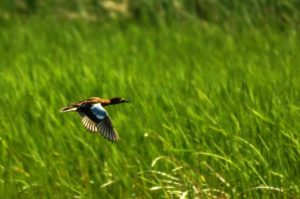Over the past many years we have enjoyed visiting Malheur National Wildlife Refuge, located 32 miles south of Burns in the high desert country of southeastern Oregon. A mecca for birdwatchers and wildlife enthusiasts, Malheur is a crown jewel of the National Wildlife Refuge System.
Malheur National Wildlife Refuge was established on August 18, 1908, by President Theodore Roosevelt. The newly established “Lake Malheur Reservation” was the 19th of 51 wildlife refuges created by Roosevelt during his tenure as president. This large refuge now consists of 185,000 acres that include Malheur, Harvey and Mud Lakes, numerous ponds in the Blitzen Valley, alkali flats, towering rimrocks and sagebrush-covered hills.
One of the highlights of the refuge is a museum with nearly 200 mounted bird specimens, giving visitors a rare close-up view of the great diversify the area has to offer.
The 43-mile self-guided auto tour route offers wildlife observations and photography opportunities. It doesn’t take long to immerse yourself in this wilderness atmosphere and to witness a great abundance of life. The sharp call of the killdeer, the gentle quack of a cinnamon teal gathering her fuzzy offspring, and the heron’s motor-like throbbing take-off remind you whose home you’re visiting. The sometimes dank smell of the marsh and even the buzz of mosquitoes demonstrate the importance of an uninterrupted food chain, sometimes uncomfortable for humans but so necessary for wildlife survival.
In January, 2016 Malheur was closed when armed militants seized the headquarters and continued to occupy it until law enforcement made a final arrest in February. The militant organizers were seeking an opportunity to advance their view that the United States Forest Service, Bureau of Land Management (BLM) and other agencies are constitutionally required to turn over most of the federal public land they manage to individual states. Unfortunately, the take-over caused significant damage to tribal artifacts, safes were broken into with money, cameras and computers stolen, a new road was bulldozed, mutilating the surrounding area, and a boat launch was damaged when militants used the area for firearms training. After the occupation, Malheur continued its closure to ensure all explosives and dangerous materials were removed, to clean up the resulting mess, and to restore the grounds. After several months of closure, the refuge is now fully open and operational.
Besides birds and waterfowl, 58 mammal species presently reside within Malheur National Wildlife Refuge.
The Visitor Center is open Monday through Friday from 8:00 am to 4:00 pm and is staffed most weekends by volunteers.
If you’re in southeastern Oregon, be sure to take time to experience this special place.



Mary, you have described the beauty of Malheur National Forrest. It was nice to recapture the history and recent incidents that led to its closure. Thank you for letting us know that it is open now. We haven’t been there, but Nitin would love to see the birds and the museum.
Thank you, Hema. Malheur is a wonderful place that I know you would enjoy. I hope you have a chance to visit.
Wouldn’t it be wonderful to be able to shake Teddy Roosevelt’s hand and say thank you for your brilliant leadership? And thanks for the reminder that mosquitoes are part of the food chain – something that is not mentioned often.
It’s hard to appreciate mosquitoes when they’re buzzing in your ears. But they are somebody’s food, after all. Thanks for your comment, Judith.
Thank you for spreading the word about Malheur! You’ve captured what makes it a special place in Oregon’s wide-open High Desert country. It’s also the home country to WWW’s own Nancy Fine, photographer and writer.
It is a special place. We’ve gone there for years, whenever we’re in the area. I always love to go into that little building with the birds and Native arrowheads. Thank you for your comment, Susan.